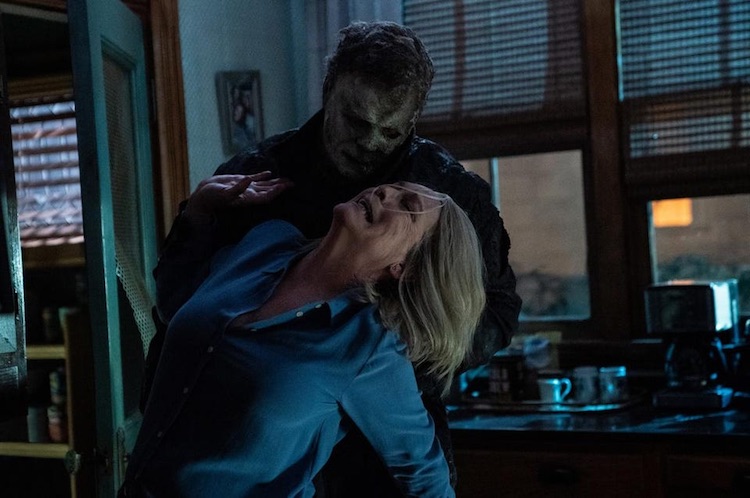
Movie Review: Halloween Ends
What We Liked
What We Didn't Like
For a movie hyping itself as the final glimpse of Michael Myers, Halloween Ends has surprisingly little of the man in the William Shatner mask.
Those expecting one last showdown between the Boogeyman and ultimate Final Girl Laurie Strode (Jamie Lee Curtis) may walk away disappointed, as Halloween Ends takes some narrative risks that might anger fans. But those willing to go with it and forgive an overstuffed plot might walk away slightly more satisfied. Like all of David Gordon Green’s entries in this series, Halloween Ends is a mess, but for the first time in the trilogy, it puts its pretensions on the back burner and lets itself have a bit of fun.
Green’s first two films took place over one hellish Halloween night, letting Michael (played here by James Jude Courtney and original Shape Nick Castle) wreak havoc in Haddonfield forty years after his first holiday massacre. This third and purportedly final entry takes place four years later, with Laurie having found some peace after Myers’ disappearance and living in a nice home with her granddaughter, Allyson (Andi Matichak).
Laurie may have moved on, but Haddonfield hasn’t. In an opening voiceover, Laurie explains that Michael’s disappearance has unnerved the town, infecting them with paranoia and anger. Violence has increased, runaways and missing children are rampant, and a general pall of distrust and bitterness has overtaken the community. In the absence of justice for their own Boogeyman, the town has made the object of its derision Corey Cunningham (Rohan Campbell), a young man falsely accused of murdering the child he was babysitting.
Screenwriters Green, Danny McBride, Paul Brad Logan, and Chris Bernier attempt to squeeze in the trilogy’s usual social commentary, with the ugly and divided side of Haddonfield representing pandemic-era vitriol, conspiracy mongering and fear culture. But the attempts feel forced, with the dialogue calling attention to itself instead of letting the themes develop organically, and the film drops much of the idea of Haddonfield as a rage-infected hamlet shortly after. Which is probably wise, as the film also tries to tell two or three additional stories, all of them fairly compelling but weakened by attempts to make it all fit.
Curtis gives a strong performance, particularly in the film’s first half. After two movies in which Laurie’s been grizzled and on the verge of a breakdown, it’s refreshing to see her be charming, her humor and smile returning the innocent, bashful heroine from the original film. Laurie still struggles with the reminders of all she’s lost, but she’s also trying to heal. As good as Curtis is as playing the badass, it’s just as enjoyable to watch her be clumsy, kind and happy, and Green seems to be setting up a finale that will see her wrestling to cling to that happiness as the horror returns.
But then, the film suggests that Green is a bit tired of the old Halloween template. The bulk of the plot actually puts Corey at the center, finally snapping after a year of abuse from the townsfolk. Despite a budding romance with Allyson that stretches credulity, Corey has had it with Haddonfield and its bullies. And a chance encounter with Michael Myers — who, surprise surprise, is very much alive and hiding in the sewers —makes Corey believe that the solution to his problems is to slash his own enemies, building his confidence while making it apparent to all but Allyson that he’s really bad news.
Halloween Ends has intriguing ideas at play, but stuffing them into a two-hour runtime means logic, pacing, and tone suffer. Corey’s seduction to the “dark side” and his romance with Allyson are an interesting direction, but the development feels rushed and forced. Laurie’s journey of healing is put on the back burner for too long and then pretty much undone to tackle third-act obligations. Ham-fisted social commentary is spouted at random but never engaged. And all the while, the film goes long stretches where it seems to forget that Michael Myers even exists. It’s unwieldy, and yet deserves some credit for trying to shake up the traditional formula.
Green thankfully abandons the self-seriousness that has plagued these later films and embraces the low-rent meanness and pitch-black humor of the slasher subgenre, and it frees the movie up to be its own weird, even fun, thing. From the opening that mimics the font of the credits in the non-Michael Myers Halloween III: Season of the Witch to the heavy synth score provided once again by John Carpenter; his son, Cody; and Daniel Davies, it’s a tonal love letter to the B-grade teen horror flicks of the 1980s. Corey’s storyline feels particularly inspired by Carpenter’s adaptation of Christine, and much of the film is filled with visual signatures to the director’s non-Halloween work. It might not all work, but in its best moments it’s stylish and fun in a way the previous two films never were.

Jamie Lee Curtis and James Jude Courtney in “Halloween Ends.”
The Corey/Allyson relationship may make no rational sense and feel rushed, but its overwrought emotions are a better fit with the heightened reality of the slasher genre. And Green pulls back on the carnage from Halloween Kills without dulling the impact of the deaths. He cuts away or keeps the most graphic images slightly offscreen, which makes them hit harder when he lingers on a particularly gruesome shot. A death by blowtorch and a pitch-black gag involving a severed tongue are particularly noteworthy, even if Green still can’t quite capture the sense of dread that Carpenter perfected.
Had Halloween Ends focused solely on the Corey storyline without having to tie up Laurie’s arc, or if the film had excised the faux killer angle to hone more tightly in on the final matchup between Laurie and Michael, it would likely work better. The Corey angle is an interesting digression, but it means Michael Myers is absent from the majority of his swan song. And even when he’s present, the link between Michael and Corey doesn’t make much sense. Is it supernatural? Is Michael a mentor, loyal companion, or confused hanger-on? If Michael truly wants revenge on Laurie, why does he spend so much time going on side quests? The film never tackles these questions, and as a result Myers often feels more like Sweetums in The Muppet Movie, running to catch up with everyone else.
Of course, he is brought back front and center for a final, bloody confrontation with Laurie (not to be confused with her final, bloody confrontations with him in Halloween, Halloween II, Halloween: H20, Halloween: Resurrection, and 2018’s Halloween). The climactic battle seems hellbent on proving that Michael Myers is gone for good (even if the film can’t fully give up the Shatner mask). By the time the credits roll, he’s suffered a final fight that reaches “Looney Tunes” levels of overkill. It should satiate fans who’ve been disappointed the masked killer has spent so much time offscreen, but even the most diehard Halloweenies might find the community-wide procession to dispose of a senior citizen’s corpse a bit much.
And, of course, the audience is too smart to believe this is truly the end of Michael Myers. While it might be the final time Curtis appears as Laurie — although we’ve heard those promises before, too — everyone knows that it’s not time to hang up the masks just yet. Whether it’s a sequel, a remake or another sequel-ignoring reboot, the Shape will return. Which is kind of disheartening; after all, the best parts of Halloween Ends suggest that perhaps leaving Michael off the screen is the best option for this franchise.



